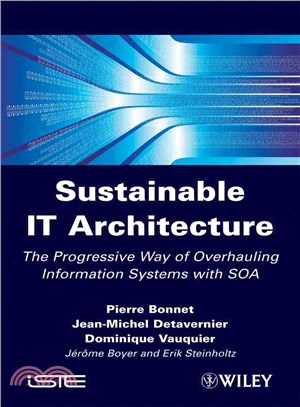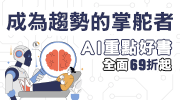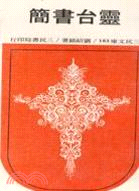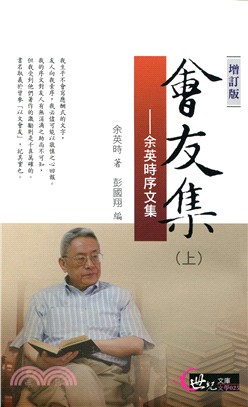Sustainable It Architecture: Resilient Information Systems
商品資訊
ISBN13:9781848210899
出版社:John Wiley & Sons Inc
作者:Bonnet
出版日:2009/05/12
裝訂/頁數:精裝/384頁
定價
:NT$ 6762 元優惠價
:90 折 6086 元
若需訂購本書,請電洽客服 02-25006600[分機130、131]。
商品簡介
作者簡介
目次
相關商品
商品簡介
This book focuses on Service Oriented Architecture (SOA), the basis of sustainable and more agile IT systems that are able to adapt themselves to new trends and manage processes involving a third party. The discussion is based on the public Praxeme method and features a number of examples taken from large SOA projects which were used to rewrite the information systems of an insurance company; as such, decision-makers, creators of IT systems, programmers and computer scientists, as well as those who will use these new developments, will find this a useful resource.
作者簡介
Pierre Bonnet is the co-founder of Orchestra Networks, a software editor specialized in Model-driven MDM. He is also the founder of the "Sustainable IT Architecture" and "MDM Alliance Group" communities.
目次
Acknowledgements.
Foreword.
Preface.
Guide for the Reader.
Introduction to the SOA Project at SMABTP.
Chapter 1. Initial Perspectives.
1.1. 50 years of computing – an overview.
1.2. What remains today?
Part I. Why a Sustainable Information System?
Chapter 2. Company-oriented Services.
2.1. Consequences of the Internet revolution.
2.2. What do the leading market players say?
2.3. What do the chief information officers think?
2.4. The issues faced at general management level.
2.5. Levels of maturity.
Chapter 3. SOA Maturity Levels.
3.1. Towards the creation of a more agile information system.
3.2. Cosmetic SOA.
3.3. Extended SOA.
3.4. Overhaul SOA.
3.5. The matrices of SOA maturity.
Chapter 4. Economic and Social Aspects.
4.1. Removal of obstacles that may slow down the progressive overhaul of an information system.
4.2. The future of IT specialists..
4.3. Off-shoring.
4.4. The generation mix.
4.5. The role of software infrastructure editors.
Part II. The Principles of SOA.
Chapter 5. The Properties of SOA.
5.1. The definition of service for users.
5.2. The definition of service for IT specialists.
5.3. The properties of basic SOA.
5.4. The properties of agility.
Chapter 6. Orchestration (BPM and SOA).
6.1. Multiple requirements in orchestration.
6.2. The levels of orchestration.
6.3. The techniques of orchestration.
6.4. Towards the homogenization of orchestration.
6.5. The benefits of orchestration.
6Part III. The Need for an Enterprise Method.
Chapter 7. The Discovery of Services (Reference Framework and Urbanization).
7.1. New needs for the information system.
7.2. Why are different methods seldom used within companies?
7.3. Reference frameworks.
7.4. Essential tools.
Chapter 8. The Praxeme Enterprise Method.
8.1. Praxeme: the initiative behind a public method.
8.2. The Praxeme method.
8.3. Enterprise system topology according to the Praxeme method.
8.4. What the Praxeme method means for SOA.
8.5. Advantages of the Praxeme method.
Chapter 9. Modeling with Praxeme.
9.1. The modeling of requirements.
9.2. Semantic modeling.
9.3. Pragmatic modeling.
9.4. Pre-modeling.
9.5. Logical modeling.
9.6. Logical modeling of batch computing.
9.7. Technical modeling.
9.8. Software modeling.
9.9. Benefits of the methodology.
Part IV. Mastering Existing Techniques.
Chapter 10. Tools for Industrializing the Method.
10.1. Requirements in the industrialization of procedures.
10.2. Frameworks and design patterns.
10.3. Tools for increased agility.
10.4. Representation tools.
10.5. Tools for tests and management.
10.5.1. Non-regression tests.
10.6. Tools for the management of different versions and the configuration of programs.
10.7. Benefits of using tools in the method.
Chapter 11. Systems Integration and Common Information Language.
11.1. New requirements in communication.
11.2. ESB's functions.
11.3. Integrating ESB into SI.
11.4. ESB’s benefits.
Chapter 12. SOA Platform.
12.1. Requirements for the global vision of technical architecture.
12.2. New technical components.
12.3. Managing performance.
12.4. Managing exploitation.
12.5. Managing maintenance.
12.6. Benefits of SOA platforms.
Chapter 13. Rules Management at the Scale of the Whole Enterprise (Jérôme BOYER, ILOG Software).
13.1. Overview.
13.2. Deep view.
13.3. When to use a rule engine.
13.4. Logical architecture view.
13.5. BRMS and SOA.
Chapter 14. Semantic Integration (Erik STEINHOLTZ, Progress Software).
14.1. Enabling the adaptive enterprise.
14.2. Inhibitors for change.
14.3. Definition of semantic integration.
14.4. Parallel track information modeling.
14.5. Change inhibitors addressed with semantic integration.
14.6. Putting it to work.
Conclusion.
Weblinks.
Bibliography.
Special Technical Note.
Index.
Foreword.
Preface.
Guide for the Reader.
Introduction to the SOA Project at SMABTP.
Chapter 1. Initial Perspectives.
1.1. 50 years of computing – an overview.
1.2. What remains today?
Part I. Why a Sustainable Information System?
Chapter 2. Company-oriented Services.
2.1. Consequences of the Internet revolution.
2.2. What do the leading market players say?
2.3. What do the chief information officers think?
2.4. The issues faced at general management level.
2.5. Levels of maturity.
Chapter 3. SOA Maturity Levels.
3.1. Towards the creation of a more agile information system.
3.2. Cosmetic SOA.
3.3. Extended SOA.
3.4. Overhaul SOA.
3.5. The matrices of SOA maturity.
Chapter 4. Economic and Social Aspects.
4.1. Removal of obstacles that may slow down the progressive overhaul of an information system.
4.2. The future of IT specialists..
4.3. Off-shoring.
4.4. The generation mix.
4.5. The role of software infrastructure editors.
Part II. The Principles of SOA.
Chapter 5. The Properties of SOA.
5.1. The definition of service for users.
5.2. The definition of service for IT specialists.
5.3. The properties of basic SOA.
5.4. The properties of agility.
Chapter 6. Orchestration (BPM and SOA).
6.1. Multiple requirements in orchestration.
6.2. The levels of orchestration.
6.3. The techniques of orchestration.
6.4. Towards the homogenization of orchestration.
6.5. The benefits of orchestration.
6Part III. The Need for an Enterprise Method.
Chapter 7. The Discovery of Services (Reference Framework and Urbanization).
7.1. New needs for the information system.
7.2. Why are different methods seldom used within companies?
7.3. Reference frameworks.
7.4. Essential tools.
Chapter 8. The Praxeme Enterprise Method.
8.1. Praxeme: the initiative behind a public method.
8.2. The Praxeme method.
8.3. Enterprise system topology according to the Praxeme method.
8.4. What the Praxeme method means for SOA.
8.5. Advantages of the Praxeme method.
Chapter 9. Modeling with Praxeme.
9.1. The modeling of requirements.
9.2. Semantic modeling.
9.3. Pragmatic modeling.
9.4. Pre-modeling.
9.5. Logical modeling.
9.6. Logical modeling of batch computing.
9.7. Technical modeling.
9.8. Software modeling.
9.9. Benefits of the methodology.
Part IV. Mastering Existing Techniques.
Chapter 10. Tools for Industrializing the Method.
10.1. Requirements in the industrialization of procedures.
10.2. Frameworks and design patterns.
10.3. Tools for increased agility.
10.4. Representation tools.
10.5. Tools for tests and management.
10.5.1. Non-regression tests.
10.6. Tools for the management of different versions and the configuration of programs.
10.7. Benefits of using tools in the method.
Chapter 11. Systems Integration and Common Information Language.
11.1. New requirements in communication.
11.2. ESB's functions.
11.3. Integrating ESB into SI.
11.4. ESB’s benefits.
Chapter 12. SOA Platform.
12.1. Requirements for the global vision of technical architecture.
12.2. New technical components.
12.3. Managing performance.
12.4. Managing exploitation.
12.5. Managing maintenance.
12.6. Benefits of SOA platforms.
Chapter 13. Rules Management at the Scale of the Whole Enterprise (Jérôme BOYER, ILOG Software).
13.1. Overview.
13.2. Deep view.
13.3. When to use a rule engine.
13.4. Logical architecture view.
13.5. BRMS and SOA.
Chapter 14. Semantic Integration (Erik STEINHOLTZ, Progress Software).
14.1. Enabling the adaptive enterprise.
14.2. Inhibitors for change.
14.3. Definition of semantic integration.
14.4. Parallel track information modeling.
14.5. Change inhibitors addressed with semantic integration.
14.6. Putting it to work.
Conclusion.
Weblinks.
Bibliography.
Special Technical Note.
Index.
主題書展
更多
主題書展
更多書展今日66折
您曾經瀏覽過的商品
購物須知
外文書商品之書封,為出版社提供之樣本。實際出貨商品,以出版社所提供之現有版本為主。部份書籍,因出版社供應狀況特殊,匯率將依實際狀況做調整。
無庫存之商品,在您完成訂單程序之後,將以空運的方式為你下單調貨。為了縮短等待的時間,建議您將外文書與其他商品分開下單,以獲得最快的取貨速度,平均調貨時間為1~2個月。
為了保護您的權益,「三民網路書店」提供會員七日商品鑑賞期(收到商品為起始日)。
若要辦理退貨,請在商品鑑賞期內寄回,且商品必須是全新狀態與完整包裝(商品、附件、發票、隨貨贈品等)否則恕不接受退貨。
























